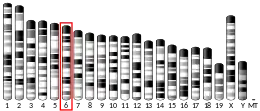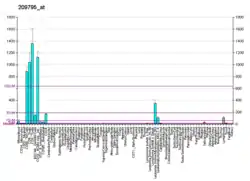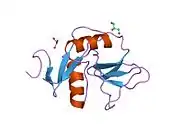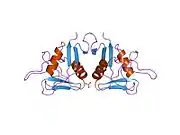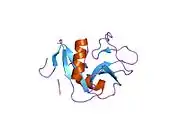CD69
CD69 (Cluster of Differentiation 69) is a human transmembrane C-Type lectin protein encoded by the CD69 gene. It is an early activation marker that is expressed in hematopoietic stem cells, T cells, and many other cell types in the immune system.[5] It is also implicated in T cell differentiation as well as lymphocyte retention in lymphoid organs.
| CD69 | |||||||||||||||||||||||||||||||||||||||||||||||||||
|---|---|---|---|---|---|---|---|---|---|---|---|---|---|---|---|---|---|---|---|---|---|---|---|---|---|---|---|---|---|---|---|---|---|---|---|---|---|---|---|---|---|---|---|---|---|---|---|---|---|---|---|
 | |||||||||||||||||||||||||||||||||||||||||||||||||||
| |||||||||||||||||||||||||||||||||||||||||||||||||||
| Identifiers | |||||||||||||||||||||||||||||||||||||||||||||||||||
| Aliases | CD69, AIM, BL-AC/P26, CLEC2C, EA1, GP32/28, MLR-3, CD69 molecule | ||||||||||||||||||||||||||||||||||||||||||||||||||
| External IDs | OMIM: 107273 MGI: 88343 HomoloGene: 128584 GeneCards: CD69 | ||||||||||||||||||||||||||||||||||||||||||||||||||
| |||||||||||||||||||||||||||||||||||||||||||||||||||
| |||||||||||||||||||||||||||||||||||||||||||||||||||
| |||||||||||||||||||||||||||||||||||||||||||||||||||
| |||||||||||||||||||||||||||||||||||||||||||||||||||
| |||||||||||||||||||||||||||||||||||||||||||||||||||
| Wikidata | |||||||||||||||||||||||||||||||||||||||||||||||||||
| |||||||||||||||||||||||||||||||||||||||||||||||||||
Function
The activation of T lymphocytes and Natural Killer (NK) cells, both in vivo and in vitro, induces expression of CD69. This molecule, which appears to be the earliest inducible cell surface glycoprotein acquired during lymphoid activation, is involved in lymphocyte proliferation and functions as a signal-transmitting receptor in lymphocytes, including natural killer (NK) cells, and platelets (Cambiaggi et al., 1992) [supplied by OMIM].[6]
Structure and ligands
The gene encoding CD69 is located in the NK gene complex on chromosome 6 and chromosome 12 in mice and humans respectively.[7] Activation signaling pathways in lymphocytes, NK cells, dendritic cells and other cell types upregulate transcription factors, such as NF-κB, ERG-1 (erythroblast transformation-specific related gene-1), and AP-1 (activator protein), in order to promote the transcription of the CD69 gene.[8][7] The CD69 protein is subject to post-translational modifications. Namely, it is differentially glycosylated to produce either a 28 kDa peptide or a 32 kDa peptide. Two of these peptides randomly combine to form a homodimer linked by a disulfide bond.[7] These subunits have a C-type lectin domain (CTLD) that binds ligands, a transmembrane domain, and a cytoplasmic tail that relays signals to the cell interior.[7]
CD69 lacks the characteristic Ca2+ binding residues in CTLDs, indicating that it might bind to proteins rather than carbohydrates, the usual ligand of CTLDs.[9][7] It has been shown that CD69 binds to Gal-1, a carbohydrate binding protein located on some dendritic cells and macrophages, in addition to Myl9/12.[8] Other ligands have yet to be identified. However, it is known that binding of the ligands initiates the Jak/Stat signaling pathway as well as the mTOR/HIF1-α pathway.[9][8][7] CD69 is also known to interact with and mediate S1P and LAT1 receptors, which influence lymphocyte egress in lymphoid organs among other responses.[10][8] More work must be done to fully characterize CD69-ligand interactions as well as CD69's method of transducing intracellular signals.
T cell differentiation
CD69 expression has been associated with both regulatory T cell (Treg), memory T cell and Bcl6 loCD69 hiLZ GC B plasmablast precursors.[11] Treg precursors exit the thymus expressing CD69 and complete differentiation into Treg cells in peripheral tissues when they encounter antigens and other cytokines, like IL-2.[12] Through the JAK/STAT signaling pathway, CD69 activation also induces the production of TGF-β as well as IL-2, which contribute to the differentiation of Treg cells as mentioned above.[8] Furthermore, CD69 is also known to be upregulated by NF-κB signaling at the onset of an immune response. A prolonged immune response is then maintained by the non-canonical NF-κB pathway, which in turn is associated with Treg differentiation.[7]
In addition to Treg differentiation, CD69 is a common marker of precursor and mature resident memory T cells (TRMs) that are localized in peripheral tissues.[13][9] TGF-β is also responsible for the development of TRMs, thus promoting TRM differentiation in a manner similar to Treg differentiation.[14]
Lymphocyte migration
Most lymphocytes express sphingosine-1-phosphate receptors (S1P1-5), which are G protein-coupled receptors located in the cell membrane that bind to the ligand sphingosine-1-phosphate (S1P). S1P is a sphingolipid metabolite that is abundant in the bloodstream and, upon binding to S1PR1, promotes lymphocyte egress from lymphoid organs so they can travel to affected tissues.[15][8] However, when a T cell is activated in a lymphoid organ through cytokine and TCR signaling, CD69 is expressed and forms a complex with S1PR1 (not S1PR3 or S1PR5). This association is dependent on the interaction between the CD69 transmembrane domain and helix-4 of S1PR1. Following formation of this complex, S1PR1 is internalized and is destroyed within the cell, inhibiting its ability to bind S1P and initiate downstream signaling. This in turn results in temporary lymphocyte retention in the lymph organs.[8] It is thought that retention of lymphocytes in the lymph nodes may increase the chance of successful lymphocyte activation, especially if the initial activation signal was weak. Similarly, CD69 expressed in thymocytes following positive selection may ensure that T cells fully mature in the thymus prior to entering circulation.[10]
Some research has shown that S1PR1 and CD69 co-regulate so that when CD69 is in greater abundance, it results in the removal of S1PR1 from the membrane as mentioned above.[10] However, if S1PR1 is more abundant than CD69, as would be the case in mature T cells, CD69 membrane localization is reduced. In this manner, regulation of CD69 and S1PR1 expression and localization jointly impact lymphocyte egress and migration.[10]
See also
References
- GRCh38: Ensembl release 89: ENSG00000110848 - Ensembl, May 2017
- GRCm38: Ensembl release 89: ENSMUSG00000030156 - Ensembl, May 2017
- "Human PubMed Reference:". National Center for Biotechnology Information, U.S. National Library of Medicine.
- "Mouse PubMed Reference:". National Center for Biotechnology Information, U.S. National Library of Medicine.
- Ziegler SF, Ramsdell F, Alderson MR (September 1994). "The activation antigen CD69". Stem Cells. 12 (5): 456–65. doi:10.1002/stem.5530120502. PMID 7804122. S2CID 22182832.
- "Entrez Gene: CD69 CD69 molecule".
- Radulovic K, Niess JH (2015). "CD69 is the crucial regulator of intestinal inflammation: a new target molecule for IBD treatment?". Journal of Immunology Research. 2015: 497056. doi:10.1155/2015/497056. PMC 4352431. PMID 25759842.
- Cibrián D, Sánchez-Madrid F (June 2017). "CD69: from activation marker to metabolic gatekeeper". European Journal of Immunology. 47 (6): 946–953. doi:10.1002/eji.201646837. PMC 6485631. PMID 28475283.
- Kimura MY, Hayashizaki K, Tokoyoda K, Takamura S, Motohashi S, Nakayama T (July 2017). "Crucial role for CD69 in allergic inflammatory responses: CD69-Myl9 system in the pathogenesis of airway inflammation". Immunological Reviews. 278 (1): 87–100. doi:10.1111/imr.12559. PMID 28658550. S2CID 4327394.
- Cyster JG, Schwab SR (2012). "Sphingosine-1-phosphate and lymphocyte egress from lymphoid organs". Annual Review of Immunology. 30: 69–94. doi:10.1146/annurev-immunol-020711-075011. PMID 22149932.
- Ise, Wataru (April 17, 2018). "T Follicular Helper Cell-Germinal Center B Cell Interaction Strength Regulates Entry into Plasma Cell or Recycling Germinal Center Cell Fate". Immunity. 48 (4): 702–715.e4. doi:10.1016/j.immuni.2018.03.027. PMID 29669250.
- González-Amaro R, Marazuela M (April 2016). "T regulatory (Treg) and T helper 17 (Th17) lymphocytes in thyroid autoimmunity". Endocrine. 52 (1): 30–8. doi:10.1007/s12020-015-0759-7. PMID 26475497. S2CID 30154540.
- Farber DL, Yudanin NA, Restifo NP (January 2014). "Human memory T cells: generation, compartmentalization and homeostasis". Nature Reviews. Immunology. 14 (1): 24–35. doi:10.1038/nri3567. PMC 4032067. PMID 24336101.
- Mueller SN, Mackay LK (February 2016). "Tissue-resident memory T cells: local specialists in immune defence". Nature Reviews. Immunology. 16 (2): 79–89. doi:10.1038/nri.2015.3. PMID 26688350. S2CID 3155731.
- Garris CS, Blaho VA, Hla T, Han MH (July 2014). "Sphingosine-1-phosphate receptor 1 signalling in T cells: trafficking and beyond". Immunology. 142 (3): 347–53. doi:10.1111/imm.12272. PMC 4080950. PMID 24597601.
Further reading
- Li Q, Lan X, Han X, Wang J (January 2019). "Expression of Tmem119/Sall1 and Ccr2/CD69 in FACS-Sorted Microglia- and Monocyte/Macrophage-Enriched Cell Populations After Intracerebral Hemorrhage". Front Cell Neurosci. 12: 520. doi:10.3389/fncel.2018.00520. PMC 6333739. PMID 30687011.
- Cambiaggi C, Scupoli MT, Cestari T, Gerosa F, Carra G, Tridente G, Accolla RS (1992). "Constitutive expression of CD69 in interspecies T-cell hybrids and locus assignment to human chromosome 12". Immunogenetics. 36 (2): 117–20. doi:10.1007/BF00215288. PMID 1612643. S2CID 20364822.
- López-Cabrera M, Muñoz E, Blázquez MV, Ursa MA, Santis AG, Sánchez-Madrid F (September 1995). "Transcriptional regulation of the gene encoding the human C-type lectin leukocyte receptor AIM/CD69 and functional characterization of its tumor necrosis factor-alpha-responsive elements". The Journal of Biological Chemistry. 270 (37): 21545–51. doi:10.1074/jbc.270.37.21545. PMID 7665567.
- Bezouska K, Nepovím A, Horváth O, Pospísil M, Hamann J, Feizi T (March 1995). "CD 69 antigen of human lymphocytes is a calcium-dependent carbohydrate-binding protein". Biochemical and Biophysical Research Communications. 208 (1): 68–74. doi:10.1006/bbrc.1995.1306. PMID 7887967.
- Santis AG, López-Cabrera M, Hamann J, Strauss M, Sánchez-Madrid F (July 1994). "Structure of the gene coding for the human early lymphocyte activation antigen CD69: a C-type lectin receptor evolutionarily related with the gene families of natural killer cell-specific receptors". European Journal of Immunology. 24 (7): 1692–7. doi:10.1002/eji.1830240735. PMID 8026529. S2CID 25826530.
- Ziegler SF, Ramsdell F, Hjerrild KA, Armitage RJ, Grabstein KH, Hennen KB, Farrah T, Fanslow WC, Shevach EM, Alderson MR (July 1993). "Molecular characterization of the early activation antigen CD69: a type II membrane glycoprotein related to a family of natural killer cell activation antigens". European Journal of Immunology. 23 (7): 1643–8. doi:10.1002/eji.1830230737. PMID 8100776. S2CID 6360771.
- López-Cabrera M, Santis AG, Fernández-Ruiz E, Blacher R, Esch F, Sánchez-Mateos P, Sánchez-Madrid F (August 1993). "Molecular cloning, expression, and chromosomal localization of the human earliest lymphocyte activation antigen AIM/CD69, a new member of the C-type animal lectin superfamily of signal-transmitting receptors". The Journal of Experimental Medicine. 178 (2): 537–47. doi:10.1084/jem.178.2.537. PMC 2191117. PMID 8340758.
- Hamann J, Fiebig H, Strauss M (June 1993). "Expression cloning of the early activation antigen CD69, a type II integral membrane protein with a C-type lectin domain". Journal of Immunology. 150 (11): 4920–7. doi:10.4049/jimmunol.150.11.4920. PMID 8496594. S2CID 44371939.
- Krowka JF, Cuevas B, Maron DC, Steimer KS, Ascher MS, Sheppard HW (January 1996). "Expression of CD69 after in vitro stimulation: a rapid method for quantitating impaired lymphocyte responses in HIV-infected individuals". Journal of Acquired Immune Deficiency Syndromes and Human Retrovirology. 11 (1): 95–104. doi:10.1097/00042560-199601010-00013. PMID 8528739.
- Iafrate AJ, Bronson S, Skowronski J (February 1997). "Separable functions of Nef disrupt two aspects of T cell receptor machinery: CD4 expression and CD3 signaling". The EMBO Journal. 16 (4): 673–84. doi:10.1093/emboj/16.4.673. PMC 1169669. PMID 9049297.
- Vance BA, Bennett MJ, Ward Y, Gress RG, Kearse KP (August 1999). "Distinct but dispensable N-glycosylation of human CD69 proteins". Archives of Biochemistry and Biophysics. 368 (2): 214–20. doi:10.1006/abbi.1999.1322. PMID 10441371.
- Blázquez MV, Macho A, Ortiz C, Lucena C, López-Cabrera M, Sánchez-Madrid F, Muñoz E (September 1999). "Extracellular HIV type 1 Tat protein induces CD69 expression through NF-kappaB activation: possible correlation with cell surface Tat-binding proteins". AIDS Research and Human Retroviruses. 15 (13): 1209–18. doi:10.1089/088922299310304. PMID 10480634.
- Llera AS, Viedma F, Sánchez-Madrid F, Tormo J (March 2001). "Crystal structure of the C-type lectin-like domain from the human hematopoietic cell receptor CD69". The Journal of Biological Chemistry. 276 (10): 7312–9. doi:10.1074/jbc.M008573200. hdl:11336/45350. PMID 11036086.
- Natarajan K, Sawicki MW, Margulies DH, Mariuzza RA (December 2000). "Crystal structure of human CD69: a C-type lectin-like activation marker of hematopoietic cells". Biochemistry. 39 (48): 14779–86. doi:10.1021/bi0018180. PMID 11101293.
- Liu X, Schrager JA, Lange GD, Marsh JW (August 2001). "HIV Nef-mediated cellular phenotypes are differentially expressed as a function of intracellular Nef concentrations". The Journal of Biological Chemistry. 276 (35): 32763–70. doi:10.1074/jbc.M101025200. PMID 11438519.
- Diament D, Brunialti MK, Romero EC, Kallas EG, Salomao R (April 2002). "Peripheral blood mononuclear cell activation induced by Leptospira interrogans glycolipoprotein". Infection and Immunity. 70 (4): 1677–83. doi:10.1128/IAI.70.4.1677-1683.2002. PMC 127819. PMID 11895929.
- Yoshimura C, Yamaguchi M, Iikura M, Izumi S, Kudo K, Nagase H, Ishii A, Walls AF, Ra C, Iwata T, Igarashi T, Yamamoto K, Hirai K (May 2002). "Activation markers of human basophils: CD69 expression is strongly and preferentially induced by IL-3". The Journal of Allergy and Clinical Immunology. 109 (5): 817–23. doi:10.1067/mai.2002.123532. PMID 11994706.
- Pisegna S, Zingoni A, Pirozzi G, Cinque B, Cifone MG, Morrone S, Piccoli M, Frati L, Palmieri G, Santoni A (July 2002). "Src-dependent Syk activation controls CD69-mediated signaling and function on human NK cells". Journal of Immunology. 169 (1): 68–74. doi:10.4049/jimmunol.169.1.68. PMID 12077230.
- Liu CC, Huang KJ, Lin YS, Yeh TM, Liu HS, Lei HY (October 2002). "Transient CD4/CD8 ratio inversion and aberrant immune activation during dengue virus infection". Journal of Medical Virology. 68 (2): 241–52. doi:10.1002/jmv.10198. PMID 12210415. S2CID 21271659.
- Foerster M, Haefner D, Kroegel C (October 2002). "Bcl-2-mediated regulation of CD69-induced apoptosis of human eosinophils: identification and characterization of a novel receptor-induced mechanism and relationship to CD95-transduced signalling". Scandinavian Journal of Immunology. 56 (4): 417–28. doi:10.1046/j.1365-3083.2002.01111.x. PMID 12234263. S2CID 21934164.
- Weigel G, Griesmacher A, Karimi A, Zuckermann AO, Grimm M, Mueller MM (October 2002). "Effect of mycophenolate mofetil therapy on lymphocyte activation in heart transplant recipients". The Journal of Heart and Lung Transplantation. 21 (10): 1074–9. doi:10.1016/S1053-2498(02)00440-0. PMID 12398872.
External links
- CD69+protein,+human at the U.S. National Library of Medicine Medical Subject Headings (MeSH)
- Human CD69 genome location and CD69 gene details page in the UCSC Genome Browser.


